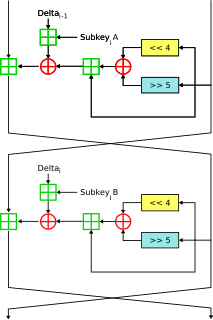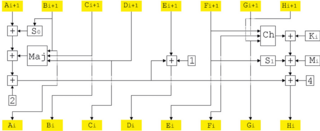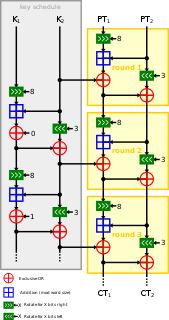Related Research Articles

The Data Encryption Standard is a symmetric-key algorithm for the encryption of digital data. Although its short key length of 56 bits makes it too insecure for applications, it has been highly influential in the advancement of cryptography.

In cryptography, the International Data Encryption Algorithm (IDEA), originally called Improved Proposed Encryption Standard (IPES), is a symmetric-key block cipher designed by James Massey of ETH Zurich and Xuejia Lai and was first described in 1991. The algorithm was intended as a replacement for the Data Encryption Standard (DES). IDEA is a minor revision of an earlier cipher Proposed Encryption Standard (PES).

The GOST block cipher (Magma), defined in the standard GOST 28147-89, is a Soviet and Russian government standard symmetric key block cipher with a block size of 64 bits. The original standard, published in 1989, did not give the cipher any name, but the most recent revision of the standard, GOST R 34.12-2015, specifies that it may be referred to as Magma. The GOST hash function is based on this cipher. The new standard also specifies a new 128-bit block cipher called Kuznyechik.

In cryptography, the Tiny Encryption Algorithm (TEA) is a block cipher notable for its simplicity of description and implementation, typically a few lines of code. It was designed by David Wheeler and Roger Needham of the Cambridge Computer Laboratory; it was first presented at the Fast Software Encryption workshop in Leuven in 1994, and first published in the proceedings of that workshop.

In cryptography, XTEA is a block cipher designed to correct weaknesses in TEA. The cipher's designers were David Wheeler and Roger Needham of the Cambridge Computer Laboratory, and the algorithm was presented in an unpublished technical report in 1997. It is not subject to any patents.

In cryptography, DES-X is a variant on the DES symmetric-key block cipher intended to increase the complexity of a brute-force attack using a technique called key whitening.

SHACAL-1 is a 160-bit block cipher based on SHA-1, and supports keys from 128-bit to 512-bit. SHACAL-2 is a 256-bit block cipher based upon the larger hash function SHA-256.

In cryptography, the boomerang attack is a method for the cryptanalysis of block ciphers based on differential cryptanalysis. The attack was published in 1999 by David Wagner, who used it to break the COCONUT98 cipher.
In cryptography, Cobra is the general name of a family of data-dependent permutation based block ciphers: Cobra-S128, Cobra-F64a, Cobra-F64b, Cobra-H64, and Cobra-H128. In each of these names, the number indicates the cipher's block size, and the capital letter indicates whether it is optimized for implementation in software, firmware, or hardware.
In cryptography, Nimbus is a block cipher invented by Alexis Machado in 2000. It was submitted to the NESSIE project, but was not selected.
In cryptography, Zodiac is a block cipher designed in 2000 by Chang-Hyi Lee for the Korean firm SoftForum.
In cryptography, CIKS-1 is a block cipher designed in 2002 by A.A. Moldovyan and N.A. Moldovyan. Like its predecessor, Spectr-H64, it relies heavily on permutations of bits, so is better suited to implementation in hardware than in software.
In cryptography, ARIA is a block cipher designed in 2003 by a large group of South Korean researchers. In 2004, the Korean Agency for Technology and Standards selected it as a standard cryptographic technique.
In cryptography, KN-Cipher is a block cipher created by Kaisa Nyberg and Lars Knudsen in 1995. One of the first ciphers designed to be provably secure against ordinary differential cryptanalysis, KN-Cipher was later broken using higher order differential cryptanalysis.
In cryptography, COCONUT98 is a block cipher designed by Serge Vaudenay in 1998. It was one of the first concrete applications of Vaudenay's decorrelation theory, designed to be provably secure against differential cryptanalysis, linear cryptanalysis, and even certain types of undiscovered cryptanalytic attacks.
This article summarizes publicly known attacks against block ciphers and stream ciphers. Note that there are perhaps attacks that are not publicly known, and not all entries may be up to date.
PRESENT is a lightweight block cipher, developed by the Orange Labs (France), Ruhr University Bochum (Germany) and the Technical University of Denmark in 2007. PRESENT is designed by Andrey Bogdanov, Lars R. Knudsen, Gregor Leander, Christof Paar, Axel Poschmann, Matthew J. B. Robshaw, Yannick Seurin, and C. Vikkelsoe. The algorithm is notable for its compact size.

Speck is a family of lightweight block ciphers publicly released by the National Security Agency (NSA) in June 2013. Speck has been optimized for performance in software implementations, while its sister algorithm, Simon, has been optimized for hardware implementations. Speck is an add–rotate–xor (ARX) cipher.

Simon is a family of lightweight block ciphers publicly released by the National Security Agency (NSA) in June 2013. Simon has been optimized for performance in hardware implementations, while its sister algorithm, Speck, has been optimized for software implementations.
Prince is a block cipher targeting low latency, unrolled hardware implementations. It is based on the so-called FX construction. Its most notable feature is the "alpha reflection": the decryption is the encryption with a related key which is very cheap to compute. Unlike most other "lightweight" ciphers, it has a small number of rounds and the layers constituting a round have low logic depth. As a result, fully unrolled implementation are able to reach much higher frequencies than AES or PRESENT. According to the authors, for the same time constraints and technologies, PRINCE uses 6–7 times less area than PRESENT-80 and 14–15 times less area than AES-128.
References
- Selçuk Kavut and Melek D. Yücel (2002). Slide Attack on Spectr-H64 (PDF). 3rd International Conference on Cryptology in India (Indocrypt 2002). Springer. doi:10.1007/3-540-36231-2_4. ISBN 9783540002635.